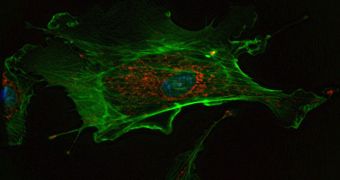Almost all types of cells in the human body are covered in sugar molecules called glycans, but analyzing and understanding these molecules has proven to be extremely difficult and hard. A new study method, dubbed by its creators the “shotgun glycomics” approach, could now make this easier.
One of the main things about glycans is that they are tremendously complex, investigators say. Due to this, studies aimed at understanding them have been relatively scarce and superficial.
Aware of this, the team behind the new work decided to cover this gap in knowledge, by converting gene chip microarray technology into a tool that was appropriate for the study of glycans.
The research group, which was based at the Emory University School of Medicine, also developed an advanced chemical technique for tagging the purified glycan molecules with fluorescent dyes.
This is very important because the fluorescence is what allows specialized microscopes to keep track of the target molecules within living cells, as the glycans go about their business.
Details of the new research appear in a paper published in the latest issue of the esteemed scientific journal Nature Methods, Science Blog reports.
“Being able to analyze glycans in this way may lead to new diagnostics for human autoimmune disorders, and perhaps, therapies to cleanse the body of self-reactive antibodies or inhibit their pathological attack on cells,” says Richard Cummings, PhD.
The official is the co-director of the Glycomics Center, and also the chair of the Emory Department of Biochemistry. He was also one of the leaders of the research team at the university.
“The structures of the glycans are unknown. This is why we use the word ‘shotgun’ to describe our quasi-random approach of studying them,” says the other co-director of the Glycomics Center, David Smith, PhD.
The expert is also the senior author of the Nature Methods paper, and a professor of biochemistry at Emory. Assistant professor of biochemistry and first author Xuezheng Song, PhD, also contributed to the new investigation.
“The sugars present on glycoproteins and glycolipids can contribute decisively to these molecules’ functions,” explains National Institutes of Health (NIH) National Institute of General Medical Sciences (NIGMS) expert Pamela Marino.
“Understanding what information is encoded in these sugars and how they facilitate interactions with other proteins has been a major road block in deciphering the molecular language of glycans,” the expert adds.
“This study, which is funded through the NIGMS EUREKA program for high risk research, has now provided proof of principle for an extremely novel ‘shotgun’ approach to interpreting this glycan code, and allows for examination of the role of glycans in infection and immunity,” she concludes.

 14 DAY TRIAL //
14 DAY TRIAL //